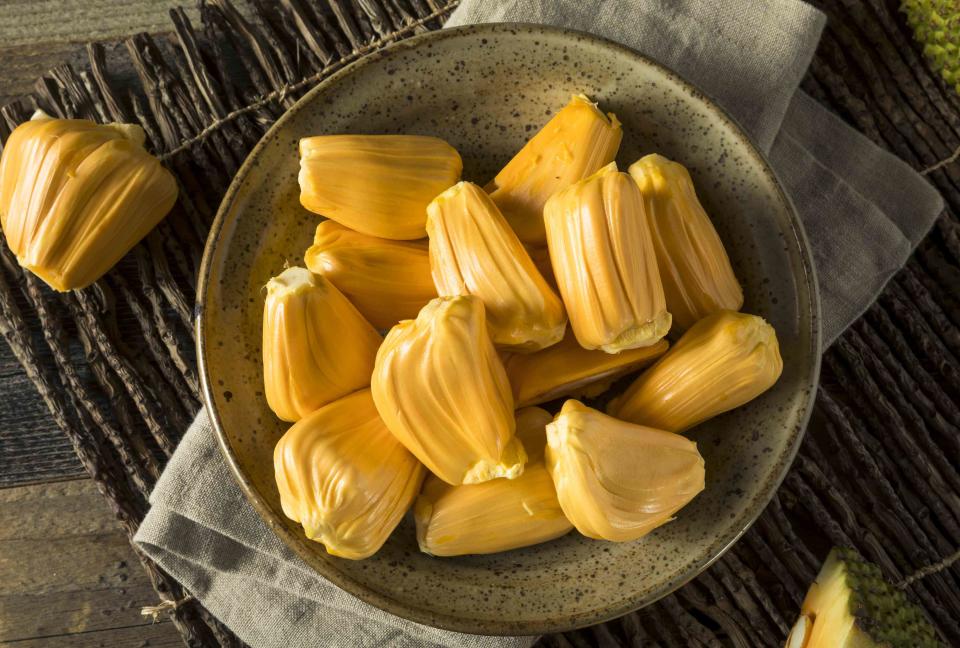Everything You Need to Know About Jackfruit
Get to know the tropical fruit that doubles as a vegan meat substitute.

bhofack2 / Getty Images
Tropical, floral-scented jackfruit has become remarkably famous in recent years across the U.S. as a star of savory plant-based cooking (looking at you, Jackfruit Carnitas). But there’s a lot more to know about the largest edible fruit on the planet — that’s right, the planet! — which is beloved across much of the world and even has festivals dedicated to it in India. Behold: A sort of comprehensive primer on the versatile, nourishing, captivating jackfruit.
What is jackfruit?
Jackfruit is a species of tree in the breadfruit, fig and mulberry family. Believed to have originated in India, it has since spread throughout Southeast Asia, the Philippines, Thailand, Malaysia, Indonesia and other tropical climates — though can survive in some subtropical places, too. The fruit itself is oblong and covered in thick, knobbly, green skin. (Though oft-confused with durian, the two aren’t at all related.) Jackfruit can weigh up to 80 pounds and reach 36 inches in length, with the average weighing in at — ahem, a modest? — 10 to 25 pounds. The interior consists of fleshy, yellowish petals that join around a smooth seed. Jackfruit is something of a nutritional powerhouse: high in protein, potassium, fiber and vitamins A and C, with about 95 calories per half a cup.
What does jackfruit taste like?
Unripe jackfruit is whitish in color, with a fibrous texture (not unlike shredded meat, in fact) and neutral flavor. When ripe, the flesh takes on a notoriously cloying — almost sickly — smell that has been compared to Juicy Fruit gum, cantaloupe, pineapple, banana, with notes of rotten onions. However, the flavor of ripe jackfruit is mildly sweet, like a gentle cross between apple, mango and banana, with a springy yet soft texture.
How to cut jackfruit
In U.S. grocery stores, you can sometimes find fresh jackfruit that’s already cut into wedges; more often it’s frozen or packed into cans in water, brine or syrup. If you get your hands on a whole one, there are a few things to note when cutting it.
Jackfruit is coated in a sticky sap, which makes it almost impossible to work with. Oil your hands and a sharp chef’s knife or cleaver with neutral oil and cover your workspace with newspaper before starting.
Cut the fruit down the middle lengthwise. Once you get halfway through, turn it 90 degrees and repeat, then split it all the way with your fingers.
Cut out the white core. Use a paring knife to help you pluck out the individual fleshy pods, removing the seeds and any white fibers. (You can eat jackfruit seeds; boil them and remove the outer shell.) Put the jackfruit in airtight containers and freeze.
Alternatively, after slicing the fruit in half, you can cut it into chunks without peeling it. Put the chunks in a large pot, cover with water and simmer for about 45 minutes, by which time the flesh will look stringy. Remove the peel, pith and seeds, then drain the flesh well. At this point you can freeze it in airtight containers.
How to cook with jackfruit
Use young, semi-ripe jackfruit more like a vegetable and fully ripe jackfruit as you would a fruit. Young, green jackfruit is something of a blank canvas, in that it can absorb herbs, spices and other flavorings. Add it to stir-fries or curries, or shred and simmer it with onions in barbecue sauce to make BBQ Jackfruit Sandwiches with Cabbage Slaw. Or cook and mix it with spiced shredded coconut and flash-fried curry leaves in idichakka thoran, a favorite lunch among Keralans in South India, where almost everyone has a jackfruit (and coconut) tree in their backyard.
Ripe jackfruit also works in sweet preparations; it plays beautifully in fruit salads, as the basis for a Tropical Sorbet, spooned over granola or oatmeal, or cooked down into rich, honeyed compote for drizzling over desserts.
For more Food & Wine news, make sure to sign up for our newsletter!
Read the original article on Food & Wine.


